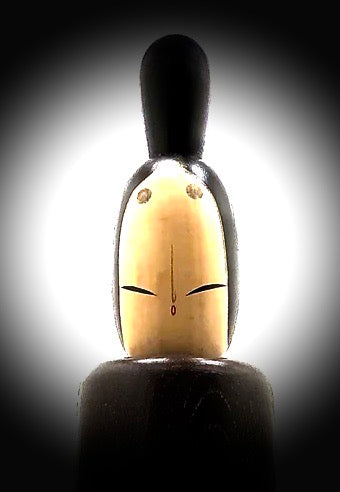


Vintage Sosaku Kokeshi entitled: “Nōbururedi | Noble Lady” by Shouzan, Shido
Dimensions: 26-0”h
This doll has inspiration from the Heian period, which was the last division of classical Japanese history when Japan entered its ‘Golden Age’, where Japanese art, poetry, and culture were at their height.
Women lived restricted life and were only allowed to enjoy certain aspects of freedom. The typical Heian beauty required a pouty mouth, narrow eyes, a thin nose, and rounded apple- cheeks. This representation has two ‘Urna’ on her forehead, spiral or circular dots of Buddhist religious significance. The particular style is VERY rare for Shouzan for it is a documentation of this specific culture in the Japanese community. Women used a heavy rice powder to paint their faces and necks white and had red rose-bud lips. All had very decorative hair typically wrapped and built up into a ‘Mage’ on the top of their head. The piece is one of the largest Kokeshi produced by Shouzan and is turned from two types of wood (Ebony and Maple), one to define the head and the other to accentuate the Obi, with the only detailed surface being her face. The original box and identification/signature/ impressed stamp remain with this doll. The piece itself is stamped “Made in Japan” and substantiates the age of the doll. (NOTE: this stamp was used from 1945-1952 and was used for pieces that were intended to be sold to foreigners). The “original” box“ has Shouzan-san's script signature with his red impressed stamp.
Condition: Excellent condition for the piece is perfect, with no missing elements or color loss, and is in exceptional condition. A beautiful, original, finish, retaining the authentic craftsmanship. The doll is of Museum-quality meeting the standards of the collector of the Sosaku Kokeshi Folk Art genre.

Artisan
Woodworker: Shido, Shouzan
1932-1995
Biographical History:
Shouzan began making Sosaku Kokeshi in 1959, soon after he graduated from Chuo University with a law degree. He is considered by Kokeshi collectors and critics alike to be arguably the most influential artist in the world of Sosaku Kokeshi doll-making. Shido-san’s main focus was depicting unadorned Northern girls in the traditional “Mino”, or Snow Coat, but he also produced tall, thin dolls, which were sparsely decorated. His keen sense of design, minimal use of color, and simple elegant shapes set him apart from his peers, making him one of the most collectible artists emerging from the creative period of the ‘60s winning various awards since 1961. He served as a judge of the All Japan Kokeshi Contest from 1970 to 1976. During that time Shozan published a book entitled Kizin Kasho comprising examples of his award-winning Kokeshi. His dolls have been collected and exhibited worldwide and winner of the Prime Minister’s Award, among many other awards.
Collector's note – descriptive qualities, standard characteristics & ornamentation styles:
Shito-san loved studying the use of combining different types of wood to gain the desired effect and to give dimension to his pieces. He also enjoyed creating slender, tall dolls to support the fact that they resemble the tall, thin trees seen throughout Japan. He incorporated a repetitive textural pattern called ‘Harmonic Chatter work’ to enhance the natural qualities of the wood in many of his works. He particularly enjoyed the textural qualities of ‘Chattering’ on the rain/snow coat, (Minomushi), which is a favorite theme, executed with minimal painted ornamentation, with an emphasis on the natural wood. In general, it is said that Japanese culture is one of modesty and humility. Occasionally saw different types of headdresses, one of which he called a ‘Tsunokakushi’, which is a wide headdress or hood, that covered elaborate hairstyles. We are told that the Japanese people regulate their behavior and response by reading faces and the eyes of others. Here, as well as elsewhere, you will see many examples of different characteristics of the eye's expressions. His most famous doll, which was considered a favorite was called “Mai”, a dancer, which was an elegant and slender doll with a beautifully formed Kimono focusing on traditional hair design (Mage) with an emphasis on a brightly colored “obi” which brings forth the best use of complex geometry to create traditional Japanese clothing elements which were created in 1970.
Shito-san was a prolific artist/woodworker of Kokeshi dolls some of which were whimsical, some focusing on calligraphy citing haiku (poems). We additionally see unusual subjects focused on Zen Buddhism and figures of Daruma, (Bodhidharma) of which most were made in a “roly-poly” type figure seen throughout festivals in Japan.
Explore & Learn More about Woodworker: Shido, Shouzan